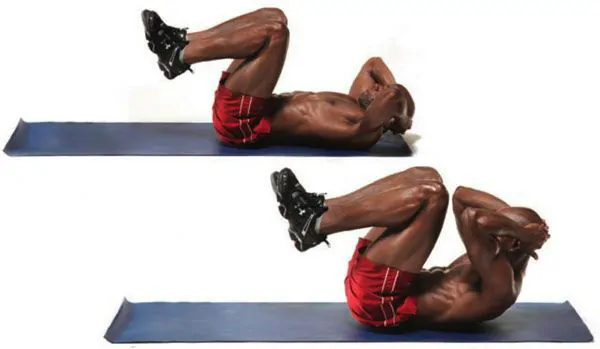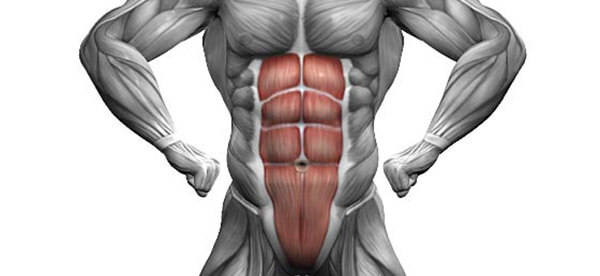In fitness, the rectus abdominis muscle has almost maximum priority. Her training focuses on both men and women. The main reason for such increased attention is its effect on the aesthetic appearance of the abdomen and the formation of the treasured abs. They serve as the main demonstration of fitness, physical fitness and body fat percentage. Understanding the structure, features and functions of the rectus abdominis muscle will allow you to make training and each exercise as effective as possible.
Anatomy of the rectus abdominis muscle
The rectus muscle is a long and solid mass that protects the abdominal wall. She takes part in most movements associated with bending the body and breathing. Also, together with the lower back muscles, it helps stabilize the body and maintain a straight body position.
The peculiarity is that throughout its entire length it is intersected by tendon constrictions. Anatomically rectus abdominis muscle originates from:
- The outer surface of the costal cartilages has 5-7 ribs (three teeth);
- Xiphoid process.
Attached to the pubic ridge.

Functions of the rectus abdominis muscle
The main task is to flex the spine in the lumbar and thoracic regions. The general functions of the rectus abdominis muscle look like this:
- Flexion of the torso, as well as the backward tilt of the pelvis with a fixed chest;
- Tension of the anterior abdominal wall;
- Lowering of the ribs when exhaling;
- Tilt of the body to the side.
In almost all functions, except for bending, there is a bilateral contraction.
How to train the rectus abdominis muscle
Doing exercises for the rectus abdominis muscle is necessary for all people, regardless of sports activities and lifestyle. It has a very strong impact not only on the level of physical fitness, but also on health. Takes part in almost all movements and sports. Even while sitting, the tone of the rectus muscle will largely determine how natural and healthy your body position will be. The main problems that will arise when the rectus abdominis muscle is weakened:
- Rounding of the back;
- Compression and disruption of internal organs;
- Risk of inguinal and umbilical hernias;
- Rotation of the pelvis and problems in the lumbar area (especially with frequent sitting);
- Formation of irregular and shallow breathing.
All these consequences can be almost guaranteed to be avoided if you pump up the rectus abdominis muscle and pay due attention to it during training.
When performing exercises, you must remember that movements for the rectus muscle have a small amplitude. This is due to its main function. Therefore, for a targeted load, it is recommended to do not classic situps, but more focused and concentrated twists.
An important point is to work out the area on both sides, dividing it into bottom and top. Sports science has proven that such a distribution is justified, since the upper and lower abs are affected by different nerve endings.
The best exercises for the rectus ab muscle
There are no special secrets in how to pump the rectus abdominis muscle. It is enough to perform several basic exercises, periodically alternating the number of repetitions, sequence and combinations of movements. It is also important to consider rest; any excessive load will lead to overtraining, which will negatively affect the growth of strength and volume.
1. Crunches
The main and most effective movement on the target muscle with an emphasis on the upper part. Performed in a small amplitude and a small number of repetitions (no more than 15). It’s important to follow ensure that exhalation is performed during peak contraction. This eliminates harmful straining and increases the efficiency of movement.
Technique:
- Lie down on the floor, rest your feet so that there is a right angle between your thigh and shin (or fix your legs in the simulator). Place your hands on your chest or on the back of your head.
- Lift your shoulder blades off the floor and begin to twist your body so that your head moves towards your knees.
- At the peak point, take a minimal pause and slowly return to the starting position without lowering your shoulder blades completely to the floor.
It is important to maintain tension in the muscles throughout the entire approach and make the movement smooth, without jerking.

2. Lying leg raises
A classic exercise with an emphasis on the lower part. Allows you to almost completely exclude other muscles, making the movement due to the strength of the rectus abdominis muscle. One of the best exercises for the rectus abdominis muscles for women, as it does not lead to a particular increase in volume. But it significantly affects muscle tone and general physical fitness.
Technique:
- Lie down on a bench or floor. Fix your hands to any support or place them along your body (to fix the position).
- Begin to slowly raise your legs together while exhaling.
- When there is a right angle between your legs and body, take a short break and at a slow pace (slightly slower than lifting) lower your legs to the starting position.

It is forbidden to lower your feet to the floor after performing a repetition; tension must be maintained throughout the entire set.
3. Exercise “bicycle”
This movement is ideal for performing in an aerobic style. It not only quickly tones the muscles, but also significantly increases endurance. It also provides easy fat burning due to better blood flow to the area during exercise.
Technique:
- Lie on the floor, fix your hands behind your head (or place them on the floor along your body).
- Raise your legs up at an angle of 30-45 degrees.
- Perform movements similar to moving pedals in the air.
This is one of the best exercises for the rectus abdominis muscle for girls if you need to focus on the lower abdomen.
4. Exercise “book”
One of the few movements that simultaneously loads the lower and upper abs.
Technique:
- Sit on a bench or floor. Tilt your body back and fix your body position with your hands. Place your feet together forward without touching the floor.
- Begin to bend your knees, pulling them towards you. Move your body forward a little (for maximum twisting).
- Pause, then move your body back and straighten your legs forward.
It is important not to touch the floor until the end of the approach.
5. Combined crunches
Another powerful movement that engages two parts of the abs at once. This is a more difficult variation of regular crunches that requires a certain level of physical fitness.
Technique:
- Lie down on the floor. Place your hands behind your head, lift your legs up and bend your knees.
- Begin to simultaneously lift your shoulder blades off the floor, performing crunches, and bring your knees as close to your head as possible.
- Pause and return to the starting position without lowering your legs and shoulder blades to the floor.

Conclusion
Most abdominal movements involve the rectus abdominis muscle, so athletes do not have difficulty pumping this area. Moreover, she takes part in many basic exercises, which provides additional training. It is much more important to ensure that the rectus muscle has time to recover. This is one of the main mistakes of beginners, who overload it with a large number of repetitions in each workout, almost completely stopping growth.
And also read how to pump up the lateral abdominal muscles →
The best abdominal exercises →


Leave a Comment